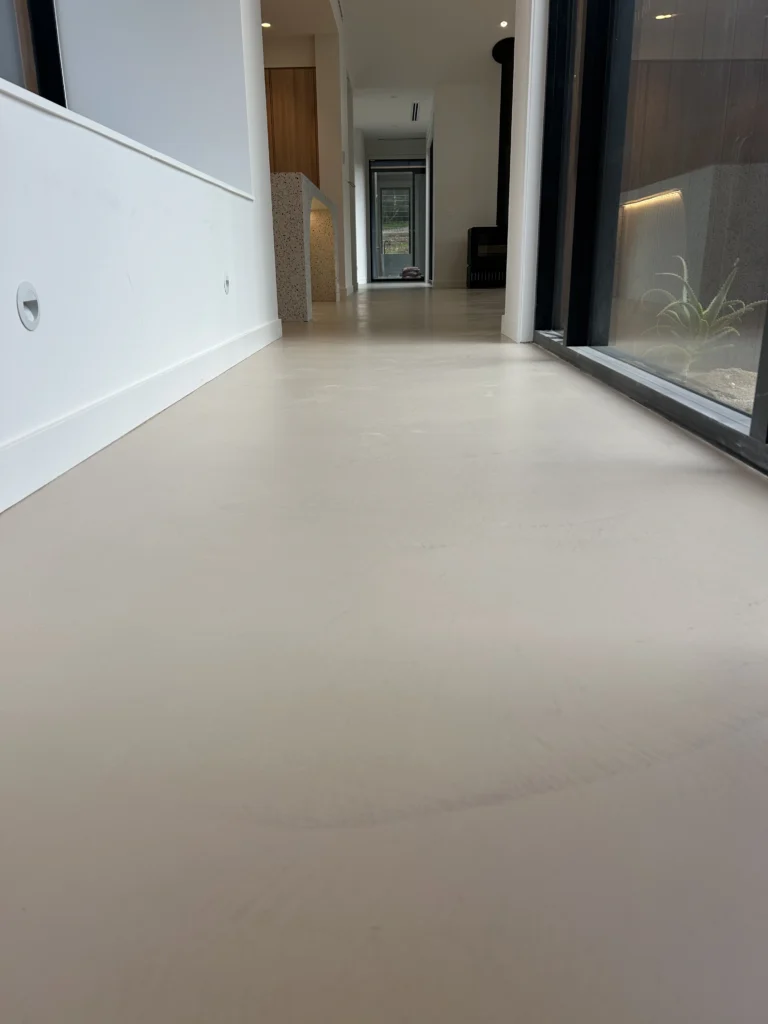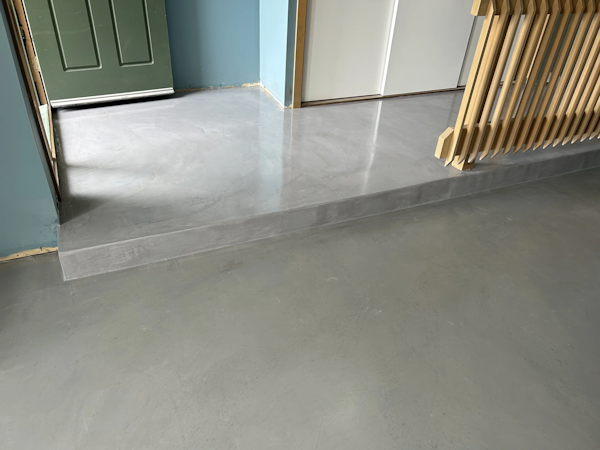Microcement vs Timber Flooring Melbourne
Choosing between microcement flooring and timber flooring often begins with comparing durability, style, maintenance, and long-term value. Both options remain popular among Melbourne homeowners and businesses, but each offers unique benefits depending on your lifestyle and design goals. Microcement has grown rapidly across the renovation scene thanks to its sleek, seamless look and ability to be installed directly over existing surfaces.
Timber flooring continues to stand out for its natural warmth, premium appearance, and impressive lifespan. This blog explores both flooring types in detail so you can choose the best option for your Melbourne home or renovation project.
Microcement’s Seamless, Modern Look
Microcement creates a completely continuous surface that visually expands a room. The finish is only 2 to 3 millimetres thick, which helps achieve a clean, minimalist look with no grout lines or seams. This smooth surface suits modern homes, open-plan living spaces, and industrial-style interiors across Melbourne.
Microcement’s application process ensures a uniform finish with minimal shrinkage, giving you a flawless, high-end appearance.
Timber Flooring’s Natural Warmth & Timeless Charm
Timber brings organic beauty to any home. The natural grain, rich tones, and warmth of timber flooring complement both classic and contemporary interiors. Whether you choose Australian hardwoods, engineered timber, or reclaimed boards, timber floors create an inviting atmosphere that never goes out of style.
The natural variation in timber adds character and helps your home stand out. It remains one of the strongest long-term design investments you can make.
Finish Options for Both Materials
Timber flooring offers a range of finishes including:
- Matte for a modern, low-glare finish that hides small scratches
- Satin for a balanced look that enhances the grain
- Gloss for a polished, luxurious appearance
Microcement can be finished in several ways including:
- Smooth contemporary finishes
- Textured surfaces for a rustic or industrial look
- Satin or matte sealers to suit your styling preferences
Colour Options
Microcement offers unlimited colour options. The material accepts pigments easily, allowing you to choose from soft neutrals, warm earthy tones, deep charcoals, or bold designer shades. This flexibility makes microcement ideal for homeowners who want custom colours or a consistent palette throughout an entire home. Timber flooring offers beautiful natural tones, but the colour range depends on species, stains, and finishes.
Scratch and Stain Resistance
Microcement is highly resistant to scratches, stains, and general wear. When sealed correctly, it stands up to daily use in kitchens, living rooms, and high-traffic areas. Its stain resistance makes it ideal for families and pet owners.
Timber flooring looks stunning but does require more care. It can scratch from furniture, pets, and high heels, and it may require refinishing over time to maintain its appearance.
Moisture Sensitivity
A properly sealed microcement floor resists water, spills, and humidity. This makes it suitable for bathrooms, laundries, and kitchens throughout Melbourne. Timber flooring is more sensitive to moisture. Humidity changes can cause boards to expand or contract, leading to cupping or crowning. Spills need fast cleaning to prevent long-term damage.
Cleaning Requirements
Microcement is one of the easiest flooring types to maintain. Regular cleaning requires only water, a mild neutral cleaner, and a soft cloth. The seamless surface means there are no joins or gaps where dirt can build up.
Timber floors need more careful cleaning. You will need a soft broom or vacuum and a timber-safe cleaner. Water must be used sparingly to avoid swelling or finish damage.
Longevity
Microcement floors can last 10 to 20 years or more when maintained correctly. The sealant can be refreshed when required.
Timber flooring offers an impressive potential lifespan of up to 100 years. With refinishing and proper care, timber becomes a long-term investment that can outlast multiple renovations.

Microcement Installation Over Existing Floors
Microcement can be applied directly over tiles, concrete, and even existing timber, which reduces demolition costs and speeds up the renovation timeline. Joints and grout lines can be filled before application to create a perfectly level base.
The entire installation typically takes 2 to 5 days, depending on the size and complexity of the space.
Timber Flooring Installation Requirements
Timber floors require more preparation. Subfloors must be level, clean, and dry. Timber also needs time to acclimatise to Melbourne’s conditions before installation begins. Installation involves careful fitting, expansion gaps, and sometimes sanding and finishing. This process often takes longer than a microcement installation.
Microcement Flooring Cost in Melbourne
Microcement flooring in Melbourne generally ranges from $200 to $380 per m², depending on the level of preparation required, the size of the area, and the type of finish selected. Because it can be applied directly over tiles, concrete, or existing flooring, many homeowners save money by avoiding demolition costs. Larger areas often achieve better value per square metre.
Timber Flooring Cost in Melbourne
Timber flooring has a wider cost range based on materials and installation needs. Engineered timber typically costs $130 to $260 per m² installed, while solid hardwood sits between $180 and $350 per m² installed. Premium Australian hardwoods or specialty finishes fall at the higher end of the range. Additional costs may apply for sanding, polishing, acoustic underlay, or subfloor preparation.
Comparison Table
|
Feature |
Microcement Flooring |
Timber Flooring |
|
Thickness |
2 to 3 mm |
Varies by board type |
|
Lifespan |
10 to 20 years |
Up to 100 years |
|
Colour Range |
Unlimited |
Natural timber tones |
|
Water Resistance |
High with sealant |
Vulnerable to moisture |
|
Scratch Resistance |
Strong |
Moderate |
|
Maintenance |
Low |
Higher |
|
Installation Time |
2 to 5 days |
Longer |
|
Melbourne Cost |
$200–$380 per m² |
$130–$350 per m² |
|
Installation Method |
Over existing floors |
Subfloor prep required |
|
Property Value Impact |
Stylish & modern |
Very high long-term value |

Microcement vs Timber Floors
Microcement and timber flooring both offer standout advantages for Melbourne homes. Microcement delivers a modern, seamless aesthetic with low maintenance and fast installation. Its design flexibility and water resistance make it ideal for contemporary renovations.
Timber flooring provides unmatched natural warmth, character, and long-term value. Although it requires more maintenance, its beauty and longevity make it a premium investment that can elevate any home.
Your decision should reflect your lifestyle, maintenance preferences, design goals, and budget. Whether you choose the sleek appeal of microcement or the timeless charm of timber, both flooring types can transform your home and create lasting impact.
